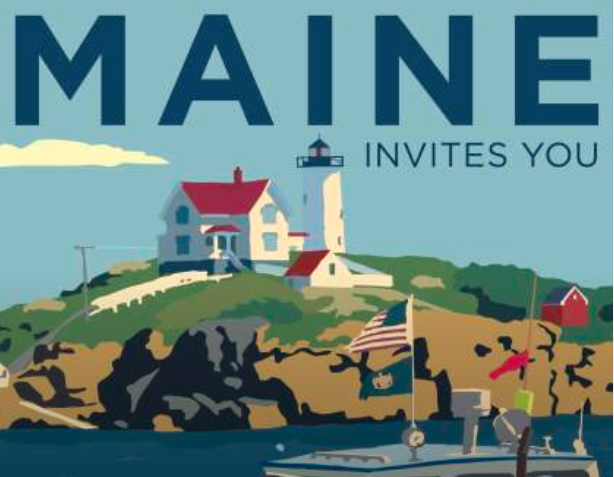It’s not enough to put “Vacationland” on your license plate, have the world’s best supply of lobster, and host an island-based national park. The tourism marketplace is congested and competitive, and for Maine to remain successful, it must respond to visitation trends.
The benefit of seeking and catering to a diverse population—including those who identify as Hispanic and LGBTQ—was one takeaway from the Governor’s Tourism Conference in Portland on April 25.
Keynote speaker Danny Guerro, CEO and founder of The Culturist Group, described himself as gay and Hispanic and noted that “culture is king” among LGBTQ and brown/black travelers. Some 93% of Hispanics travel with family, and 36% of Hispanic millennials travel with their parents.
“Tourism assets are also what make people want to live here.”
—DECD Commissioner Heather Johnson
The size of this market should not be ignored, Guerro said, with 25% of Gen Z (born between thee late 1990s and early 2010s) identifying as Hispanic/Latino, 14% identifying as black, and 6% identifying as Asian. He argued that “multi-cultural and inclusive marketing is mainstream marketing.”
Guerro recounted a story from friends who, he said, were harassed in a bar in Nashville because they were gay. “That’s what comes to mind now when I think of Nashville,” he said.
Maine’s tourism numbers from last year were good—visitation was down slightly, to 15.2 million from 15.3 million in 2022.
But spending was up—$9 billion, up from $8.6 billion in 2022, probably tied to inflation. Individual visitor spending increased from $563 in 2022 to $593 in 2023.
Spending in the tourism sector supports 131,000 jobs and $5.7 billion in wages, according to state contracted analysts, saving $2,400 in household taxes.
And an important indicator for Maine, the average number of night stays, also was up, from 4.5 to 4.8.
Speakers acknowledged that the rainy summer last year dampened the market, since travelers today are savvy enough to check forecasts before booking. A precipitation graph showed higher rates in May, June, July, August, and September in 2023 over 2022.
In her remarks, Heather Johnson, commissioner of the Department of Economic and Community Development, which includes the Maine Office of Tourism, speculated that the rainy weather may have driven visitors to restaurants, thereby increasing spending.
She also noted that what lures visitors to Maine for vacations might also boost population.
“Tourism assets are also what make people want to live here,” she said.
One wrinkle whose impact will not be known until next year is the recent eclipse.
“The eclipse traveler,” coming to Maine because of it being in the path of totality, “was a really unique and different traveler,” Johnson said. Many were surprised at the lively and interesting towns they found, she said, citing anecdotal reporting.
Among the state’s strategic goals in 2022 was increasing off-season visitation; in 2023, fall and winter visitation increased from 6.2 million to 6.7 million. Still, 52% visited in spring and summer.
One 2022 strategic goal for the state that was not met was growing the number of non-white visitors; the 2022 rate of 11% remained unchanged in 2023.
Sara Meaney of the Coraggio Group, a firm contracted by the state, emphasized that the industry must see itself as stewards of tourism assets, which include:
• Community well-being and inclusion
• Protection and respect for heritage and culture
• Environmental preservation and ecological balance
• Economic value and prosperity
She urged players in the industry to “amplify the essence of Maine” to attract the travelers who are best aligned with the state’s experiences and ethos, and to prioritize diversification of visitors.
Joseph St. Germain of the firm Downs & Germain Research explained the tourism marketing brand pillars:
• Escape to nature
• Small town spirit
• Food
• A place to pause
The culinary draw is especially appealing to millennials and Gen Z, he said. And nationwide research shows that 90% of travelers want to experience a destination “like a local.”
The Maine Office of Tourism includes just a handful of staff and so it relies on outside contractors for research and marketing. Jordan Kuglitsch of the firm Miles Partnership reported that New England, the Mid-Atlantic states, and Eastern Canada remain the primary markets, but efforts are expanding to Tampa, Orlando, Miami, and Jacksonville in Florida, as well as Raleigh-Durham in North Carolina, and Chicago.
Another wrinkle in Maine tourism is cruise ship visits. Steve Lyons, director of the tourism office, reported that 355 cruise ships visited Maine ports in 2023 resulting in 386,799 passenger days. Bar Harbor saw 129 ships, Portland 117, and Eastport 17.
For more information on the numbers, see MaineTourismConference.com.





